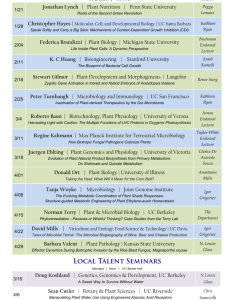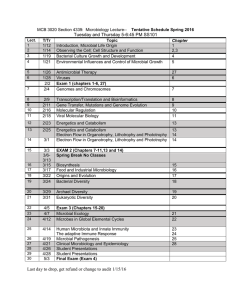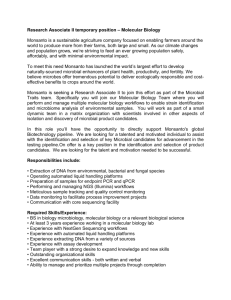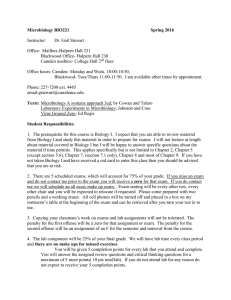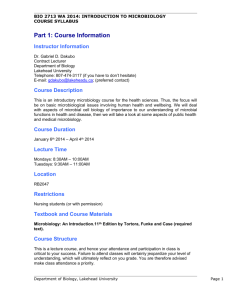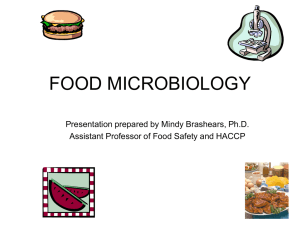Collaboration between Environmental
advertisement
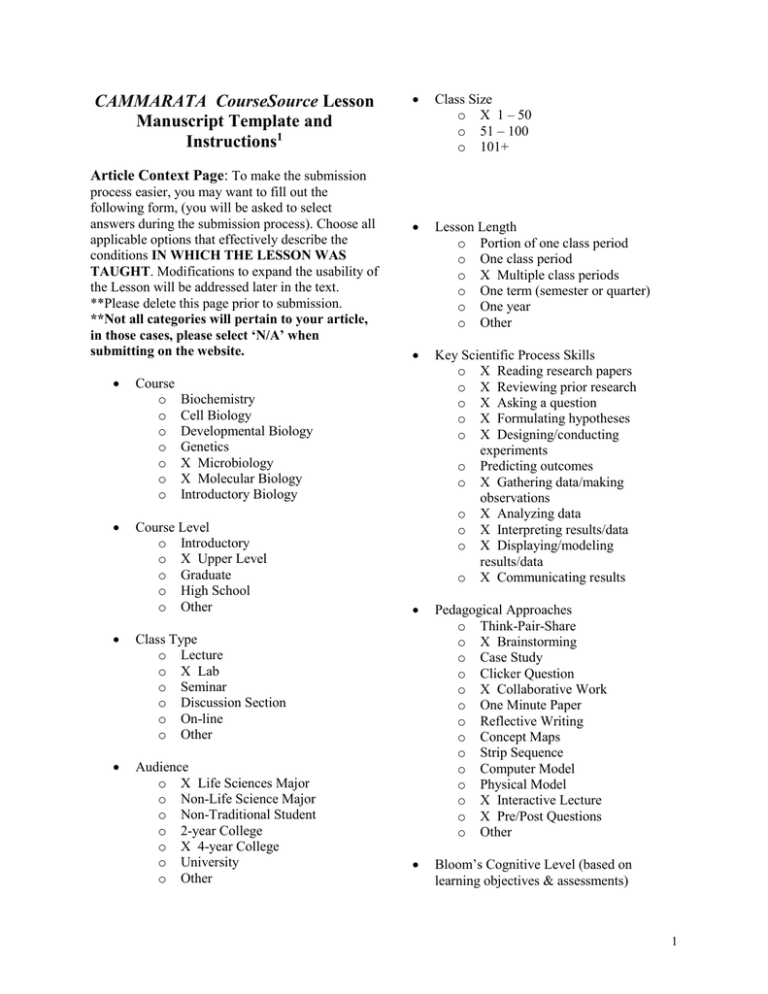
CAMMARATA CourseSource Lesson Manuscript Template and Instructions1 Class Size o X 1 – 50 o 51 – 100 o 101+ Lesson Length o Portion of one class period o One class period o X Multiple class periods o One term (semester or quarter) o One year o Other Key Scientific Process Skills o X Reading research papers o X Reviewing prior research o X Asking a question o X Formulating hypotheses o X Designing/conducting experiments o Predicting outcomes o X Gathering data/making observations o X Analyzing data o X Interpreting results/data o X Displaying/modeling results/data o X Communicating results Pedagogical Approaches o Think-Pair-Share o X Brainstorming o Case Study o Clicker Question o X Collaborative Work o One Minute Paper o Reflective Writing o Concept Maps o Strip Sequence o Computer Model o Physical Model o X Interactive Lecture o X Pre/Post Questions o Other Bloom’s Cognitive Level (based on learning objectives & assessments) Article Context Page: To make the submission process easier, you may want to fill out the following form, (you will be asked to select answers during the submission process). Choose all applicable options that effectively describe the conditions IN WHICH THE LESSON WAS TAUGHT. Modifications to expand the usability of the Lesson will be addressed later in the text. **Please delete this page prior to submission. **Not all categories will pertain to your article, in those cases, please select ‘N/A’ when submitting on the website. Course o o o o o o o Biochemistry Cell Biology Developmental Biology Genetics X Microbiology X Molecular Biology Introductory Biology Course Level o Introductory o X Upper Level o Graduate o High School o Other Class Type o Lecture o X Lab o Seminar o Discussion Section o On-line o Other Audience o X Life Sciences Major o Non-Life Science Major o Non-Traditional Student o 2-year College o X 4-year College o University o Other 1 o o o X Foundational: factual knowledge & comprehension X Application & Analysis X Synthesis/Evaluation/Creation Principles of how people learn o X Motivates student to learn material o X Focuses student on the material to be learned o Develops supportive community of learners o Leverages differences among learners o Reveals prior knowledge o X Requires student to do the bulk of the work Vision and Change Core Concepts o X Evolution o Structure and Function o Information flow, exchange and storage o X Pathways and transformations of energy and matter o X Systems Vision and Change Core Competencies o Ability to apply the process of science o Ability to use quantitative reasoning o Ability to use modeling and simulation o Ability to tap into the interdisciplinary nature of science o Ability to communicate and collaborate with other disciplines o Ability to understand the relationship between science and society Key Words: List 3 – 10 key words that are relevant for the Lesson (e.g. mitosis; meiosis; reproduction; egg; etc.) o 16S rRNA o Microbial diversity o Biofilms o Microbial community structure o Seagrass epiphytes o Environmental conditions o o o o 2 Scientific Teaching Context Page Learning Goal(s): Appreciate biological relevance of microbial diversity Understand limitations of the biological tools available at a given time and both advantages and limitations of new technologies that alter our knowledge and perspectives Understand how both informatics tools and genome-wide or community-wide approaches can advance our understanding of a system Learning Objective(s): Describe the ecological relevance and importance of microbial diversity Describe the shortcomings of traditional methods of microbial diversity characterization Describe how 16S signature gene sequences can be used to characterize microbial diversity, and explain the underlying evolutionary basis for this approach Describe some limitations of a 16S signature gene sequencing approach for understanding how a complex microbial community functions Design a robust and well-controlled 16S metagenomics expt Outline both the wet lab and subsequent bioinformatics tasks used to generate and process metagenomic datasets Describe appropriate quality control and statistical tools used for analysis of metagenomic results Present typical metagenomic results for public evaluation via publication/presentation 3 Main Text 1. Introduction: Outline Who’s there ? What are they doing ? How can we figure this out ? How can we learn more about the functioning of complex microbial communities ? Old methods vs newer methods NGS revolution Approaches & skills Doing it and analyzing it Origin & Rationale Currently have an 8 wk lab experience for Molecular Biology Lab students where they use molecular tools (DNA isolation, PCR, cloning & sequencing, basic bioinformatics) to characterize microbial identity and diversity in a complex environmental sample. It provides a “bridge” between divergent student groups in traditional field biology/ecology and molecular sciences (see poster P8). I plan to update the approach by incorporating modern NGS/bioinformatics technologies, and to expand the delivery by incorporating a similar approach into other courses. The lesson plan proposed here will involve collaboration between students in two courses to further bridge the aforementioned gap, and to demonstrate a (sort of) interdisciplinary collaboration. Vision for two-course collaborative effort: An upper division Environmental Microbiology course (w/lab) will perform experiments and wet-lab activities, while an upper division Introductory Genomics course (no lab) will perform the bioinformatics analysis of generated data. Students will interact near the project start for planning purposes, in the transition period (from wet lab to bioinformatics), and again near project end for final discussion of results. Background Complex communities of organisms (eg biofilms) play important but largely undefined roles in the physiology of many organisms, and in ecology overall. Community diversity, biotic interactions, and ecological function are key aspects to understand these communities. But because we now know that traditional culture-dependent microbiological approaches, at best, only poorly characterize complex microbial communities, it is important for our future scientists to acquire the skills to apply the best scientific approaches available, and to learn how to evaluate the data. In this case, NGS-based 16S signature-gene metagenomic approaches provide a remarkable level of diversity characterization and environmental condition-based enrichments. And as a next step, whole-genome metagenomic approaches can provide insight into the enrichment of biochemical functions in a complex microbiome. The study system chosen here (biofilms colonizing estuarine seagrass plants) is relevant to our students by geography (local coastal environment) and discipline (marine biology and biomedical sciences represent the two largest concentrations of student majors). Meaningful, hypothesis-driven biological experiments can be performed in both mesocosms (aquaria) and the field. Seagrasses are submerged, rooted, flowering plants that inhabit estuarine and marine environments. Large seagrass beds perform critical ecological functions including primary productivity (photosynthesis), carbon sequestration, sediment stabilization from erosive forces (storms, boating), and habitat refugia for marine food chains that support important food and recreational benefits to humans, Unfortunately, seagrasses are in decline globally and anthropogenic stressors such as eutrophication, hydrodynamic 4 alterations and overfishing are largely to blame (Orth et al 2006, xxx, xxx). Biofilms of diverse organisms (algae, bacteria, fungi and meiofaunal grazers) colonize the leaves of seagrasses, and they can overwhelm the leaf by both biomass and spatial coverage (see Fig 1). This coverage can disrupt leaf function by blocking available light, diminishing gas exchange processes, and possibly also through specific biotic interactions. Excessive epiphyte accumulations are associated with reduced seagrass biomass. Water column nutrients from eutrophication stimulates growth of algal epiphytes much more than the underlying seagrass leaf (a “bottom-up” ecological effect). Likewise, overfishing top marine predators (shark, tuna and most commercial fishes) reduces mid-trophic-level fish populations that feed on the meiofaunal grazers of the algal epiphytes. This too can lead to excessive epiphyte accumulations and concomitant seagrass decline (a “top-down” ecological effect). The interactive effects of environmental conditions with seagrasses and colonizing biofilms are otherwise poorly understood. But microbial communities are known to be both indicators and drivers of the biogeochemical environment within biofilms, so systematic study of how the biofilm microbial communities respond to environmental variations could provide critical insight into a key global resource. Intended Audience: Jr/Sr level students in the following Life Science tracks: Microbiology, Marine Biology, Cell & Molecular Biology Students would be expected to have a basic understanding of cell and molecular biology, microbiology and genetics, appropriate for a junior level student. Prerequisites for Environmental Microbiology are Microbiology and Genetics. Prerequisites for the Genomics course additionally include two of the following: Cell Biology, Molecular Biology, Biochemistry. Learning time: 8 weeks (= 24 hrs) for each class, but staggered (see tentative schedule) Pre-requisite student knowledge: All students would be expected to have a basic understanding of cell and molecular biology, microbiology and genetics, appropriate for a junior level student. Prerequisites for Environmental Microbiology are Microbiology and Genetics. Traditional microbiology and pipetting technical skills are expected. Prerequisites for the Genomics course additionally include two of the following: Cell Biology, Molecular Biology, Biochemistry. Basic computer skills and some familiarity with web-based bioinformatics programs (eg BLAST) are expected. 2. Scientific Teaching Themes: Read foundational/seminal papers in metagenomics, microbial ecology and seagrass ecology Discussion of papers in class Peer-teaching Experimental design Wetlab hands-on experimentation Interdisciplinary/interclass collaboration, brainstorming and results sharing/presentation 5 (Whole class working on 1 project: barcoded samples divided amongst grps) Drylab hands-on bioinformatics analyses Assessment: Pre-assessment Grp discussion participation & experimental design Experimental execution Grp discussion & presentations of results (PPTs) Post-project reflection essay to self-evaluate Exam questions Post-assessment Inclusive Teaching: ???? Discussions, peer-teaching, experimental design, and hands-on activities will encourage participation by all. 2. Lesson Plan: Sequence: microbial diversity; domains of life – 16S; what is metagenomics?; case studies in metagenomics; Blast, Trees; PCR; Barcoding; Linux; process data; analyze data; presentation/assessment; Closing conclusions/remarks/post-assessment Env Micro: Some background on the system; select topics; design expts Week Environmental Microbiology 1 Project Intro - Paper reading w/ leading questions - Students brainstorm ideas (questions & expts) Joint Class Mtg: Discussion of research & analysis plans - Microbial ecology & expts Finalize planning & prep for expts Conduct expts & harvest materials Prep DNA, quant & PCR Analyze PCR, pool & quant; Submit for sequencing 2 3 4 5 6 7 8 9 Genomics Project Intro - Paper reading w/ leading questions - Students brainstorm ideas (Data analysis steps; Data format & Quantity) Joint Class Mtg: Discussion of research & analysis plans - 16S metagenomics & data analysis Metagenomics analyses Metagenomics analyses Metagenomics analyses 6 10 11 12 Joint Presentations & discussions (Allowance for disaster) Metagenomics analyses Joint Presentations & discussions (Allowance for disaster) 4. Teaching Discussion: Share your observations about the Lesson’s effectiveness in achieving the stated learning goals and objectives, student reactions to the Lesson, and your suggestions for possible improvements or adaptations to different courses or student populations. Subheadings: can be included within the sections above to increase readability and clarity. 7
